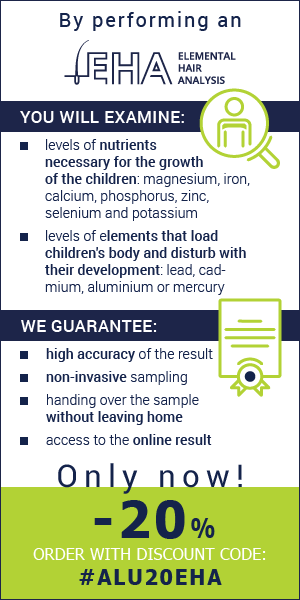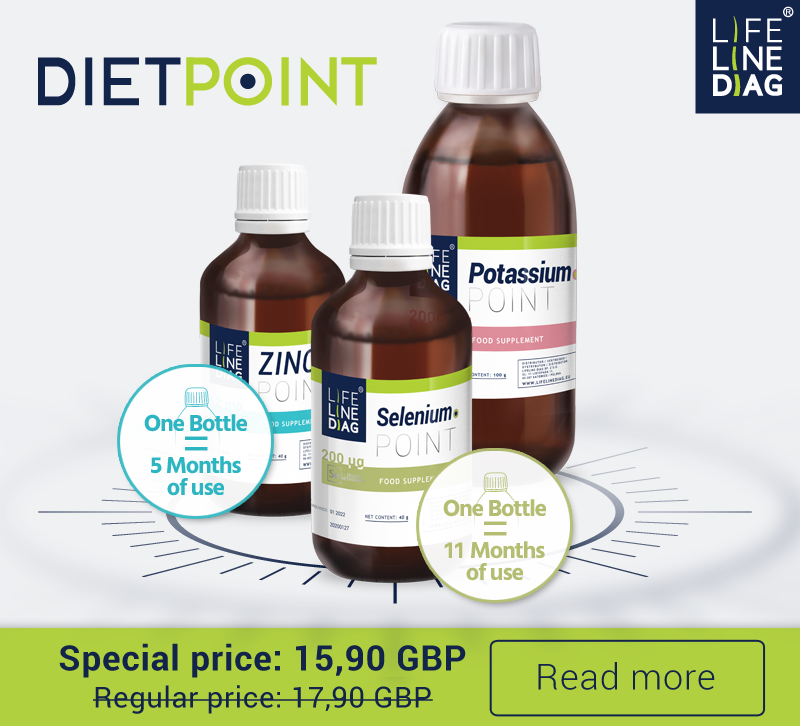
Interview with Lucyna Adamus, paediatrician
When should an elemental hair analysis
be performed for children?
L.A.: If you’re confident that your child is healthy, elemental hair analysis isn’t necessary. Unfortunately, from the paediatric point of view, this is not common. Try to look at your child with loving parental eyes, but critically. Does anything arouse your doubts? Your child is generally healthy, but isn’t growing well or has a poor appetite, or is picky and eats only certain products, has stomach pain and bloating. Or perhaps your child has weak hair, dry skin, blemishes, blackheads, or acne? Perhaps it’s none of these things. That’s great! How are they doing in kindergarten or at school? Maybe they’re considered ’empty-headed’, that they get lost in their thoughts, have trouble concentrating, or don’t keep up with their teacher or peers. Or perhaps they cause problems, are moody, tearful, explosive or even aggressive. Of course, there are many explanations for this; however, it could be worth looking into?
If you’re confident that your child is healthy, elemental hair analysis isn’t necessary. Unfortunately, from the paediatric point of view, this is not common.
How can EHA help?
L.A.: When a child is sick, especially ‘all the time’ or chronically, we have no doubt that something must be done. We listen to doctors’ advice, perhaps even see a specialist, consult doctors who are friends, or we try to broaden our knowledge rummaging through the Internet. Despite this, we’re often unsatisfied with the results. Our child is still sick. It’s in these situations where EHA should be the next diagnostic test.
What will the EHA results tell us about our child’s health?
L.A.: Elementa Hair Analysis will show whether there has been toxic metal poisoning, whether there are element deficiencies, how the nervous and endocrine systems are functioning, and whether the body is acidic or overloaded with stress. This is very valuable information.
How is EHA better than other tests?
L.A.: Elementa Hair Analysis isn’t similar to morphology, ESR, or blood sodium or glucose levels, which reflect the situation that exists at the time the blood is taken. EHA shows the state of regulation of the body in the long term. Acute diseases don’t have a big effect on the results. Disturbances that last for months or years are what’s important. That’s why you shouldn’t say: ‘He’s always had it, nothing can be done, it’s normal for him.’ It might turn out that disturbances that have lasted for several years can be improved. This is true especially for children; it’s not worth delaying tests, because the kids are growing, and their tissues and organs are getting built; simply put – their bodies, which they’ll use for their entire adult life, are being created.
What problems can we assess by analysing children’s hair?
L.A.: Contrary to appearances, children often have deficiencies of iron, magnesium, silicon, and iodine. Just as often, toxic elements such as lead, cadmium, aluminium and mercury are accumulated.
How do toxic substances get into young bodies?
L.A.: The reasons vary; however, I’d like to highlight one, which is the most common cause of cadmium poisoning in children, i.e. passive smoking. It’s often one of the reasons some kids get sick.
What other problems do children have?
L.A.: Chronic stress is underestimated by parents. They sometimes mistakenly believe that a child doesn’t understand, or that they easily forget. Many children are subjected to stress over many years, because they’re either worried about the health of a parent or sibling (children consider pets to be family), or they live in a pathological family, in which stress is normal, or they are very worried about conflicts with friends or problems at school. Parents themselves also, often unintentionally, may excessively stress their children with too many extracurricular activities, by transferring professional rivalry onto the shoulders of pre-schoolers, or by disrespecting their grandparents, because to the child, they’re their favourite people. Another important factor for the development of a child is, of course, a proper diet. Modern population-based research in affluent countries shows that a large number of children are malnourished. It’s a paradox. Parents don’t appreciate the quality of food. Sometimes, children are overfed, even obese, but at the same time they’re malnourished in terms of quality. In addition, the products most commonly given to children, such as sweets, cookies, fruit juices from a bottle or carton, popular, sugar-filled soft drinks, ice cream, potato chips, French fries, milk from a carton, colourful jelly and chewing gum, lollipops … all of these severely acidify the body. This is why not only does tooth decay come, but allergies get worse, susceptibility to fungal and other infections increases, as do anxiety and mood swings, irritability, fluctuations in appetite, and skin lesions. The metabolism and hormone functions are also disturbed, and minerals and vitamin turnover is adversely affected.
EHA is an excellent solution for children, especially those who are hyperactive. Often, behavioural problems pass when unruly students supplement magnesium deficiency.
So, is it worth performing elemental hair analysis for your child?
L.A.: Absolutely. It’s a preventive test that everyone should have done regularly. And it’s particularly important when there are allergies, psoriasis, vitiligo, frequent infections, recurrent diarrhoea, obesity, various problems growing up, including mood disorders. . Elemental hair analysis individually assesses the type of disorder and often helps you understand what the problem is. It also helps evaluate how to achieve an inner balance of the body, resulting in health. This is for the good of your child.
Lucyna Adamus
Paediatrician and family doctor, treating her patients in a state-owned clinic, as well as a private practice, where she successfully uses homeopathy. She has also been interested in allopathic methods for many years.
.













